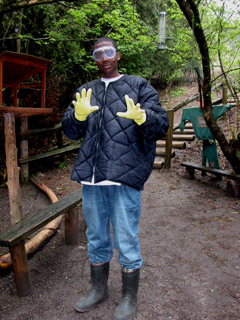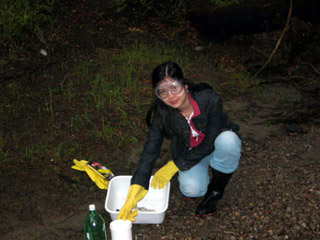Water Quality—Important Safety Information
Collecting samples safely
1. Safety is the first consideration when collecting samples for observation. All skin that could potentially be in contact with the water must be covered. Wear safety goggles and sturdy, closed-toe shoes with a good tread when collecting samples.

2. If you come in contact with the water samples, avoid placing your hands in contact with eyes, nose, and mouth until after you have washed your hands with soap and water.
3. As a universal precaution, participants who have exposed cuts or open sores should not collect water samples.
4. Always check the depth of the water where you will be monitoring before you enter the water, which should be no higher than a student's knees.
5. Avoid splashing and playing in the waterway. Avoid approaching the waterway from steep banks.
6. Safety includes the safety of the area where samples are collected. Not every student needs to trample sensitive areas looking for biological materials.

Safe testing: Protect yourself and your equipment
1. Avoid contact between reagent chemicals and skin, eyes, and mouth.
2. Wear safety goggles or glasses when handling reagent chemicals.
3. Use the test-tube caps or stoppers, not your fingers, to cover test tubes during shaking or mixing. Shake away from yourself and others on your project team.
.jpg?n=4242)
4. When dispensing a reagent from a plastic squeeze bottle, hold the bottle vertically upside down and gently squeeze it.
5. Wipe up any reagent chemical spills, liquid or powder, as soon as they occur. Rinse the area with a wet sponge, then dry. Keep a spill kit of clean water, clean sponges, and dry wipes for accidents.
6. Thoroughly rinse test tubes before and after each test. Dry your hands and the outside of the tube.
7. Tightly close all reagent containers immediately after use. Do not interchange caps from different containers.
8. Avoid prolonged exposure of equipment and reagents to direct sunlight. Protect them from extremely high temperatures and from freezing.
9. Labels on each LaMotte reagent container also provide important information pertaining to the nature of the reagents.
This content has been re-published with permission from SEED. Copyright © 2025 Schlumberger Excellence in Education Development (SEED), Inc.

